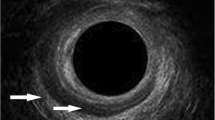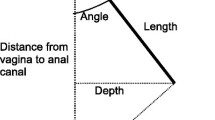Abstract
Introduction and hypothesis
Postpartum anal incontinence is common and distressing for women. We sought to look at the prevalence of anal incontinence in women who sustained obstetric anal sphincter injuries (OASI) compared with women who did not, and factors leading to these symptoms during the postpartum period.
Methods
A total of 129 primiparous women sustaining OASI were compared with 131 women who did not (controls). They were contacted at approximately 6–10 weeks postpartum to obtain information on their symptoms of anal incontinence (AI). The data underwent univariate and multivariate analysis.
Results
There was no difference in the prevalence of AI symptoms, occurring in 30% of women with OASI, and 23% of women without at 6–10 weeks postpartum; however, in women with high-grade tears the prevalence was 59%. Severe OASI (grade 3c and 4) was associated with an increased prevalence of both AI and severe AI, whereas forceps delivery and increasing maternal age were associated with an increased prevalence of severe AI only.
Conclusion
Women with less severe (grade 3a and 3b) OASI do not experience a higher prevalence of AI than women without OASI in the postpartum period. Higher grade (3c and 4) tears, forceps delivery and increasing maternal age are associated with higher rates of AI. These factors should be avoided where possible to reduce postpartum AI. All women should be warned of the 23–30% chance of experiencing some mild AI in this period. Whether these symptoms are transient or long-lasting requires further investigation.
Similar content being viewed by others
Abbreviations
- AI:
-
Anal incontinence
- OASI:
-
Obstetric anal sphincter injury
- SMIS:
-
St Mark’s Incontinence Score
References
Nordenstam J, Altman D, Brismar S, Zetterstrom J. Natural progression of anal incontinence after childbirth. Int Urogynecol J. 2009;20(9):1029–35. https://doi.org/10.1007/s00192-009-0901-2.
Gommesen D, Nohr EAA, Qvist N, Rasch V. Obstetric perineal ruptures—risk of anal incontinence among primiparous women 12 months postpartum: a prospective cohort study. Am J Obstet Gynecol. 2020;222(2):165.e1-11. https://doi.org/10.1016/j.ajog.2019.08.026.
Tucker J, Clifton V, Wilson A. Teetering near the edge; women’s experiences of anal incontinence following obstetric anal sphincter injury: an interpretive phenomenological research study. Aust N Z J Obstet Gynaecol. 2014;54(4):377–81. https://doi.org/10.1111/ajo.12230.
Sultan AH. Editorial: obstetrical perineal injury and anal incontinence. Clin Risk. 1999;5(6):193–6. https://doi.org/10.1177/135626229900500601.
Solans-Domenech M, Sanchez E, Espuna-Pons M, Pelvic Floor Research Group. Urinary and anal incontinence during pregnancy and postpartum incidence, severity, and risk factors. Obstet Gynecol. 2010;115(3):618–28. https://doi.org/10.1097/AOG.0b013e3181d04dff.
Fitzpatrick M, O’Herlihy C. The effects of labour and delivery on the pelvic floor. Best Pract Res Clin Obstet Gynaecol. 2001;15(1):63–79. https://doi.org/10.1053/beog.2000.0149.
Burgio KL, Borello-France D, Richter HE, FitzGerald MP, Whitehead W, Handa VL, et al. Risk factors for fecal and urinary incontinence after childbirth: the childbirth and pelvic symptoms study. Am J Gastroenterol. 2007;102(9):1998–2004. https://doi.org/10.1111/j.1572-0241.2007.01364.x.
Bols EMJ, Hendriks EJM, Berghmans BCM, Baeten C, Nijhuis JG, De Bie RA. A systematic review of etiological factors for postpartum fecal incontinence. Acta Obstet Gynecol Scand. 2010;89(3):302–14. https://doi.org/10.3109/00016340903576004.
Burrell M, Dilgir S, Patton V, Parkin K, Karantanis E. Risk factors for obstetric anal sphincter injuries and postpartum anal and urinary incontinence: a case-control trial. Int Urogynecol J. 2015;26(3):383–9. https://doi.org/10.1007/s00192-014-2478-7.
Roos AM, Sultan AH, Thakar R. St. Mark’s incontinence score for assessment of anal incontinence following obstetric anal sphincter injuries (OASIS). Int Urogynecol J. 2009;20(4):407–10. https://doi.org/10.1007/s00192-008-0784-7.
Linneberg S, Leenskjold S, Glavind K. A five year follow-up of women with obstetric anal sphincter rupture at their first delivery. Eur J Obstet Gynecol Reprod Biol. 2016;203:315–9. https://doi.org/10.1016/j.ejogrb.2016.06.018.
Box GEP, Tidwell PW. Transformation of independent variables. Technometrics. 1962;4(4):531. https://doi.org/10.2307/1266288.
Ramalingam K, Monga AK. Outcomes and follow-up after obstetric anal sphincter injuries. Int Urogynecol J. 2013;24(9):1495–500. https://doi.org/10.1007/s00192-013-2051-9.
Nazir M, Stien R, Carlsen E, Jacobsen AF, Nesheim BI. Early evaluation of bowed symptoms after primary repair of obstetric perineal rupture is misleading—an observational cohort study. Dis Colon Rectum. 2003;46(9):1245–50. https://doi.org/10.1097/01.dcr.0000084340.44237.3b.
Faltin DL, Boulvain M, Floris LA, Irion O. Diagnosis of anal sphincter tears to prevent fecal incontinence—a randomized controlled trial. Obstet Gynecol. 2005;106(1):6–13. https://doi.org/10.1097/01.aog.0000165273.68486.95.
Fenner DE, Genberg B, Brahma P, Marek L, DeLancey JOL. Fecal and urinary incontinence after vaginal delivery with anal sphincter disruption in an obstetrics unit in the United States. Am J Obstet Gynecol. 2003;189(6):1543–9. https://doi.org/10.1016/j.ajog.2003.09.030.
Johannessen HH, Wibe A, Stordahl A, Sandvik L, Backe B, Morkved S. Prevalence and predictors of anal incontinence during pregnancy and 1 year after delivery: a prospective cohort study. BJOG. 2014;121(3):269–80. https://doi.org/10.1111/1471-0528.12438.
Laine K, Skjeldestad FE, Sanda B, Horne H, Spydslaug A, Staff AC. Prevalence and risk factors for anal incontinence after obstetric anal sphincter rupture. Acta Obstet Gynecol Scand. 2011;90(4):319–24. https://doi.org/10.1111/j.1600-0412.2010.01057.x.
Abramowitz L, Sobhani I, Ganansia R, Vuagnat A, Benifla JL, Darai E, et al. Are sphincter defects the cause of anal incontinence after vaginal delivery? Results of a prospective study. Dis Colon Rectum. 2000;43(5):590–6. https://doi.org/10.1007/bf02235567.
Nelson RL, Go C, Darwish R, Gao JP, Parikh R, Kang C, et al. Cesarean delivery to prevent anal incontinence: a systematic review and meta-analysis. Tech Coloproctol. 2019;23(9):809–20. https://doi.org/10.1007/s10151-019-02029-3.
Deane RP. Operative vaginal delivery and pelvic floor complications. Best Pract Res Clin Obstet Gynaecol. 2019;56:81–92. https://doi.org/10.1016/j.bpobgyn.2019.01.013.
Joris F, Hoesli I, Kind A, Ries J, Kavvadias T. Obstetrical and epidemiological factors influence the severity of anal incontinence after obstetric anal sphincter injury. BMC Pregnancy Childbirth. 2019;19:7. https://doi.org/10.1186/s12884-019-2238-2.
Pretlove SJ, Thompson PJ, Toozs-Hobson PM, Radley S, Khan KS. Does the mode of delivery predispose women to anal incontinence in the first year postpartum? A comparative systematic review. BJOG. 2008;115(4):421–34. https://doi.org/10.1111/j.1471-0528.2007.01553.x.
Kamm MA. Obstetric damage and fecal incontinence. Lancet. 1994;344(8924):730–3. https://doi.org/10.1016/s0140-6736(94)92213-6.
Sultan AH, Kamm MA. Faecal incontinence after childbirth. Br J Obstet Gynaecol. 1997;104(9):979–82.
Sorensen M, Tetzschner T, Rasmussen OO, Bjarnesen J, Christiansen J. Sphincter rupture in childbirth. Br J Surg. 1993;80(3):392–4. https://doi.org/10.1002/bjs.1800800343.
Caudwell-Hall J, Atan IK, Brown C, Rojas RG, Langer S, Shek KL, et al. Can pelvic floor trauma be predicted antenatally? Acta Obstet Gynecol Scand. 2018;97(6):751–7. https://doi.org/10.1111/aogs.13315.
Author information
Authors and Affiliations
Contributions
R.E.: data analysis, manuscript writing; M.B.: protocol development, data collection, data analysis; K.M.: statistical guidance, manuscript editing; K.P.: data collection; V.P.: data collection; E.K.: project development, manuscript editing.
Corresponding author
Ethics declarations
Conflicts of interest
None.
Additional information
Publisher’s note
Springer Nature remains neutral with regard to jurisdictional claims in published maps and institutional affiliations.
Rights and permissions
About this article
Cite this article
Everist, R., Burrell, M., Mallitt, KA. et al. Postpartum anal incontinence in women with and without obstetric anal sphincter injuries. Int Urogynecol J 31, 2269–2275 (2020). https://doi.org/10.1007/s00192-020-04267-8
Received:
Accepted:
Published:
Issue Date:
DOI: https://doi.org/10.1007/s00192-020-04267-8




